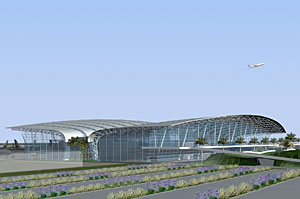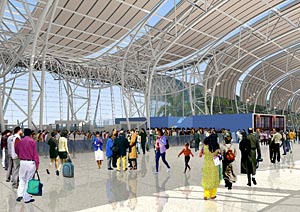The Airports Authority of India has chosen plans by a team of architects including Frederic Schwartz Architects, Hargreaves Associates, Gensler, and New Delhi-based Creative Group to expand the Chennai International Airport’s domestic and international terminals. When completed in 2010, the $300 million project will transform Chennai, located in the city formerly known as Madras, into India’s greenest airport.


The revamped Kamraj Domestic Terminal will feature what designers describe as a “green gate”: a parking garage with a green roof and rainwater capture systems. Two one-acre gardens will form a central element within the terminal (top). The terminal’s wing-like curved roof is supported on large, full-height columns. The forward slope of these elements will work with the stiffness of the trusses to resist transverse wind and seismic forces. Along the building’s 984-foot length, the V-shaped configuration of support columns will work integrally with a compression truss to create a repetitive series of stable triangulated elements to resist longitudinal forces. Large, arching space-frame trusses will allow for column-free public spaces on both the landside and airside terminal areas. Expansive glass curtain walls will boost the feeling of airiness and spaciousness, as will skylights (above).
The Kamraj Domestic Terminal, in particular, will showcase sustainable technologies. The 23-year-old building currently measures 139,931 square feet and handles 4.74 million passengers a year. Its revamped design will allow it to accommodate twice as many passengers in a three-story structure 984 feet long, encompassing some 781,460 square feet.
The organization of security and circulation forms the basis of the plan, which centers around two lush, ecologically sustainable gardens measuring nearly an acre apiece. “These gardens are visible throughout the terminal creating a unique dialogue between interior and exterior spaces,” says Frederic Schwartz, who together with Creative Group was also recently awarded the commission to design a new terminal at India’s Raipur airport, in the country’s central region.
A parking garage with a green roof will create what the designers describe as a “green gate” to the terminal. “The folding geometry of the green roof captures and directs rain water during the rain season to the elliptical openings in the roof, creating shimmering ‘rain curtains’ as the water falls through the garage to cisterns below. This stored water is later used during the dry season to irrigate the green roof and maximize the site’s sustainable resources.”
Gurpreet Shah, a Creative Group principal, notes that rain harvesting is mandated by Indian law. But Chennai’s decision to go green was largely a voluntary one. Although the country is working to adopt the LEED rating system, the program will not cover airports. “We are conscious about it and will try to incorporate as much [sustainable technology] as we can,” Shah says.




Post a comment to this article
Report Abusive Comment